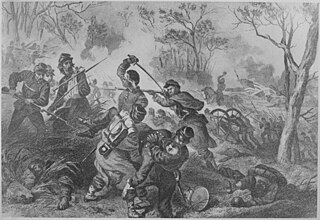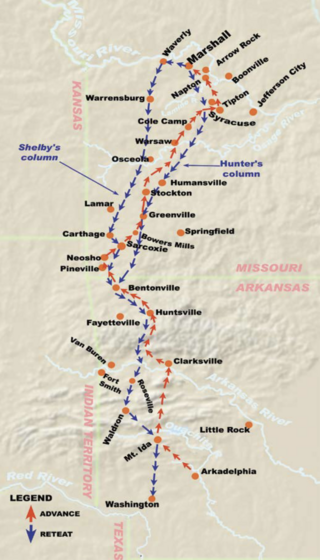
The siege of Port Hudson was the final engagement in the Union campaign to recapture the Mississippi River in the American Civil War. While Union General Ulysses Grant was besieging Vicksburg upriver, General Nathaniel Banks was ordered to capture the lower Mississippi Confederate stronghold of Port Hudson, Louisiana, to go to Grant's aid. When his assault failed, Banks settled into a 48-day siege, the longest in US military history up to that point. A second attack also failed, and it was only after the fall of Vicksburg that the Confederate commander, General Franklin Gardner, surrendered the port. The Union gained control of the river and navigation from the Gulf of Mexico through the Deep South and to the river's upper reaches.
The Second Battle of Springfield took place during the American Civil War on January 8, 1863, in Springfield, Missouri. It is sometimes known as The Battle of Springfield. Fighting was urban and house-to-house, which was rare in the war.

The siege of Knoxville saw Lieutenant General James Longstreet's Confederate forces besiege the Union garrison of Knoxville, Tennessee, led by Major General Ambrose Burnside, in the American Civil War. When Major General William T. Sherman approached Knoxville with an overwhelming Union force, Longstreet ended the siege on December 4 and withdrew northeast. The siege was part of the Knoxville campaign of the Civil War.
The Battle of Prairie D'Ane, also known as the Skirmish at Prairie D'Ane, Battle of Gum Springs, or Battle of Moscow, was fought in present-day Nevada County, Arkansas, as part of the Camden Expedition, during the American Civil War. The Camden Expedition was launched by Union forces as part of the Red River Campaign of 1864. U.S. planners envisioned two federal armies converging simultaneously, one force under the command of Maj. Gen. Nathaniel Banks pressing northward up the Red River commencing at Alexandria, Louisiana and the other federal army under the command of Maj. Gen. Frederick Steele driving southwestward from Little Rock, Arkansas. The objective was to press the rebel army of Gen. E. Kirby Smith back upon the rebel stronghold at Shreveport and defeat him. If successful, a somewhat vague second phase envisioned the two federal armies combining into one large force and continuing their offensive with a westward push into Texas.

The Battle of Port Gibson was fought between a Union Army commanded by Major General Ulysses S. Grant and a reinforced Confederate States Army division led by Major General John S. Bowen. Though the outnumbered Confederate soldiers fought stubbornly, they were steadily pressed back during the day by Major General John A. McClernand's troops. Bowen eventually conceded the field by withdrawing north toward Vicksburg, Mississippi. The battle occurred near Port Gibson, Mississippi, during the Vicksburg Campaign of the American Civil War.

The Battle of Honey Springs, also known as the Affair at Elk Creek, on July 17, 1863, was an American Civil War engagement and an important victory for Union forces in their efforts to gain control of the Indian Territory. It was the largest confrontation between Union and Confederate forces in the area that would eventually become Oklahoma. The engagement was also unique in the fact that white soldiers were the minority in both fighting forces. Native Americans made up a significant portion of each of the opposing armies and the Union force contained African-American units.
The Camden Expedition was the final campaign conducted by the Union Army in south Arkansas during the Civil War. The offensive was designed to cooperate with Major-General Nathaniel P. Banks' movement against Shreveport.
The Battle of Old Fort Wayne, also known as Maysville, Beattie's Prairie, or Beaty's Prairie, was an American Civil War battle on October 22, 1862, in Delaware County in what is now eastern Oklahoma.

During the American Civil War, Arkansas was a Confederate state, though it had initially voted to remain in the Union. Following the capture of Fort Sumter in April 1861, Abraham Lincoln called for troops from every Union state to put down the rebellion, and Arkansas along with several other southern states seceded. For the rest of the civil war, Arkansas played a major role in controlling the Mississippi River, a major waterway.
The 36th Iowa Infantry Regiment was an infantry regiment that served in the Union Army during the American Civil War.

The 1st Regiment Arkansas Volunteer Infantry (1863–1865) was an infantry regiment that served in the Union Army during the American Civil War. Although Arkansas joined the Confederate States of America in 1861, not all of its citizens supported secession. Arkansas formed some 48 infantry regiments to serve in the Confederate Army, but also formed another 11 regiments that served in the Union Army.

Shelby's Raid, also known as Shelby's Great Raid, was a Confederate cavalry incursion into Arkansas and Missouri during the American Civil War in 1863. Led by Colonel Joseph Orville Shelby, the raid took place from August 21, 1863, to November 3, 1863, covering over 800 miles across territories in west central and northwest Arkansas, as well as southwest and west central Missouri.

During the American Civil War, most of what is now the U.S. state of Oklahoma was designated as the Indian Territory. It served as an unorganized region that had been set aside specifically for Native American tribes and was occupied mostly by tribes which had been removed from their ancestral lands in the Southeastern United States following the Indian Removal Act of 1830. As part of the Trans-Mississippi Theater, the Indian Territory was the scene of numerous skirmishes and seven officially recognized battles involving both Native American units allied with the Confederate States of America and Native Americans loyal to the United States government, as well as other Union and Confederate troops.
The Van Buren raid occurred in Crawford County, Arkansas, on December 28, 1862, during the American Civil War. After defeating Confederate forces led by Major General Thomas C. Hindman at the Battle of Prairie Grove on December 7, 1862, Union forces under Brigadiers General James G. Blunt and Francis J. Herron prepared for a raid against the Confederate positions at Van Buren and Fort Smith. Disease, lack of supplies, and desertion had previously forced Hindman to begin withdrawing most of his force from the area. Setting out on December 27, the Union troops struck an outlying Confederate cavalry unit near Drippings Spring, north of Van Buren, on the morning of December 28. The Confederate cavalry fled to Van Buren, which was then overrun by Union troops.
The 54th United States Colored Infantry was an infantry regiment that served in the Union Army during the American Civil War. The regiment was composed of African American enlisted men commanded by white officers and was authorized by the Bureau of Colored Troops which was created by the United States War Department on May 22, 1863.

The ambush of the steamboat J.R. Williams was a military engagement during the American Civil War. It took place on June 15, 1864, on the Arkansas River in the Choctaw Nation which became encompassed by the State of Oklahoma. It is popularly termed the "only naval battle" in that landlocked state. It was a successful Confederate attack on the Union Army's lines of supply. The Confederate forces were Cherokee, Choctaw, Chickasaw and Creek Indians led by General Stand Watie, who was a Cherokee.
The First Battle of Cabin Creek occurred from July 1 to July 2, 1863, Mayes County, Oklahoma during the American Civil War. Confederate forces, led by Colonel Stand Watie, sought to ambush a Union supply convoy commanded by Colonel James Monroe Williams. However, Williams received advance warning of the attack. Despite the swollen waters of the creek due to rain, Williams launched a successful assault on the entrenched Confederate position, forcing them to retreat. Although a Confederate Army detachment attempted to raid a Union Army supply train bound for Fort Gibson in July 1863, they were unable to impede the Union detachment, which contributed to the Union's victory in the Battle of Honey Springs later that month. Notably, this battle marked the first instance of African American troops fighting alongside their white comrades.
The 3rd Missouri Infantry Regiment served in the Confederate States Army during the American Civil War. The infantry regiment was officially mustered into service on January 17, 1862. It fought at the Battle of Pea Ridge in Arkansas in March before being transferred across the Mississippi River. While stationed at Corinth, Mississippi, the regiment played a minor role in the Battle of Farmington before the evacuation of the town. In September, the unit saw light action at the Battle of Iuka before being heavily engaged during the Second Battle of Corinth as the Confederates attempted to retake the town in October. In early 1863, the regiment was transferred to Grand Gulf, Mississippi, in order to strengthen the defenses of the Mississippi River at that point. At the Battle of Grand Gulf on April 29, the unit helped repulse a Union Navy attack against the Confederate defensive works. After elements of the Union Army of the Tennessee landed below Grand Gulf, the regiment fought in a delaying action at the Battle of Port Gibson on May 1.
The Little Rock Campaign, officially known as Advance of the Union forces upon Little Rock, Arkansas, was a campaign conducted by the Union Army in Arkansas during the American Civil War. The strategic offensive was designed to capture Little Rock.

The Battle of McGuire's Store was fought at McGuire, Arkansas, near Elkins, between Union forces led by Brigadier General Francis J. Herron and Confederate forces under Colonel Jesse L. Cravens during the American Civil War. The skirmish was the result of an attempt by Union Brigadier General John Schofield to trap a body of Confederate cavalry reported to be at McGuire's Store. In the event, the operation failed when Herron's column took the wrong road and approached from the west instead of the north. Herron's well-equipped troops attacked Cravens' poorly armed and demoralized Texas cavalrymen and drove them off. This minor clash and other events caused Confederate Major General Thomas C. Hindman to suspend his intended advance to recover northwestern Arkansas and withdraw to the Arkansas River. Ironically, most of Schofield's soldiers also retreated to Missouri after the fight. Though the clash was minor, it marked one pulse of the ebb and flow of the war in northwest Arkansas.









